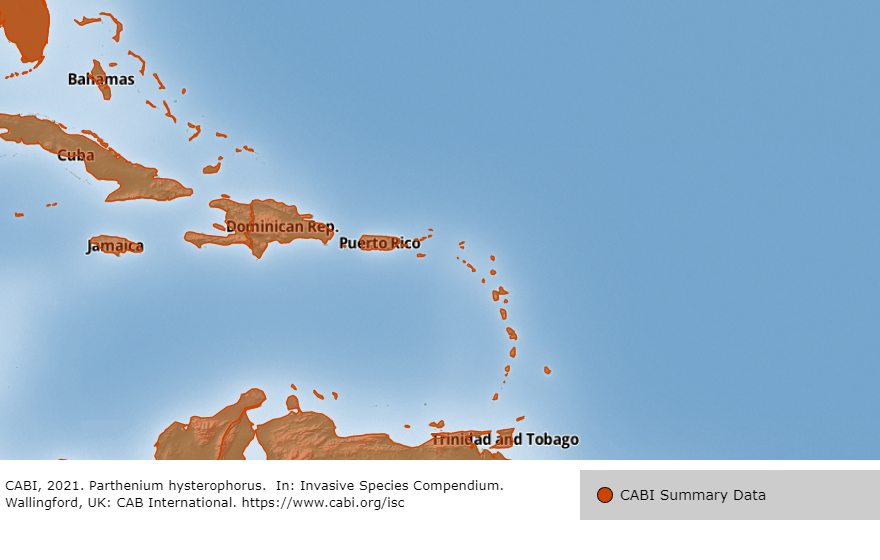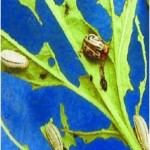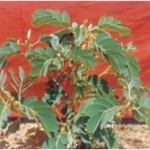This highly invasive weed is native to North and South America. It is widespread throughout the tropics causing serious economic impact to crop production. It also has reportedly caused loss of livestock and even death in humans. In Queensland, Australia, losses to the cattle industry due to Parthenium has been estimated to be Au$ 16 m per year in terms of control costs and loss of pasture.
A single plant can produce up to 100,000 seeds in a single lifecycle contributing to the invasivesness of this species. Manual uprooting before flowering when the soil is wet is the most effective control strategy as it is resistant to a range of herbicides.
SPECIES DESCRIPTION
Scientific name: Parthenium hysterophorus
Common names: Carrot weed, white top, Congress grass, star weed
Taxonomic position:
Division: Magnoliophyta
Class: Magnoliopsida, Order: Asterales
Family: Asteraceae
Native range: This pest is native to North and South America.
Distribution: Argentina, Australia, Bangladesh, China, Cuba, Dominican Republic, Ethiopia, Haiti, Honduras, India, Jamaica, Madagascar, Mauritius, Mexico, Mozambique, Nepal, New Caledonia, Pakistan, Papua New Guinea, Puerto Rico, South Africa, Sri Lanka, Swaziland, Trinidad, the United States of America, Venezuela, Vietnam and West Indies.
Distribution Map (CABI ISC):

ECOLOGY
Habitat description: Parthenium grows luxuriantly in wastelands and vacant lands, orchards, forestlands, flood plains, agricultural areas, scrub/scrublands, urban areas, overgrazed pastures and along roadsides and railway tracks. Drought, and subsequent reduced pasture cover, creates the ideal situation for Parthenium to establish. It prefers alkaline, clay loam to heavy black clay soils, but tolerates a wide variety of soil types. The weed grows well in areas where the annual rainfall is greater than 500 mm and falls dominantly in summer. It can grow up to an elevation of 2200 m above sea level.
Reproduction and life cycle: Flowering occurs about a month after germination. The fruit is cypsella. Each flower contains five seeds, which are wedge-shaped, black, 2 mm long with thin white scales. A large single plant produces up to 100,000 seeds in its lifecycle. More than 340 million seeds per ha can be present in the surface soil. Seeds do not have a dormancy period and are capable of germinating anytime when moisture is available.
Dispersal and spread: The seeds are mainly dispersed globally through water currents, animals and the movement of vehicles, machinery, livestock, grain, stock feed and other produce, and to a lesser extent by the wind. Most of the long distance spread is through vehicles, farm machinery and flooding.
IMPACT
Human health effects: In humans, the pollen grains, airborne pieces of dried plant materials and roots of Parthenium can cause allergy-type responses like hay fever, photodermatitis, asthma, skin rashes, peeling skin, puffy eyes, excessive water loss, swelling and itching of mouth and nose, constant cough, running nose and eczema. In India, an extensive outbreak of weed dermatitis caused by Parthenium allergy involving around 1,000 patients and including some deaths has been reported.
Economic effects (Negative): In Queensland, Australia, losses to the cattle industry due to Parthenium has been estimated to be Au$ 16 m per year in terms of control costs and loss of pasture.
Potential Economic effects (Positive): Parthenium is reported to have insecticidal, nematicidal and herbicidal properties; it can also be used for composting.
MANAGEMENT STRATEGIES:
Mechanical and cultural: Manual uprooting of Parthenium before flowering and seed setting is the most effective method. This is easily done when the soil is wet. Uprooting the weed after seed setting will increase the area of infestation. Pulling a plant in flower will aid in the dispersal of pollen grains, resulting in allergic reactions as well. Ploughing the weed in before the plants reach the flowering stage and establishing pastures or other plants may be effective.
Chemical control: A large number of chemicals have been tried. The use of glyphosate, atrazine, and metribuzin has been promising. The timing of chemical control is critical. The plants should be treated before flowering and seed setting and when other plants, especially grass, are actively growing and can recolonize the infested area. In open wasteland, non-cropped areas and along railway tracks and roadsides, the spraying of a solution of common salt (sodium chloride) at 15-20% concentration has been found effective.
Biological: Several insects and pathogens have been tried from time to time. The leaf-feeding beetle Zygogramma bicolorata as well as the stem-galling moth Epiblema strenuana are widely used in several countries to manage Parthenium. Z.bicolorata is now widely used in India to control Parthenium. In Australia, both the insects have been tried successfully. The moth significantly reduces flower and seed production of the weed. It has a relatively high reproduction in a short period of time and its effectiveness against Parthenium has been validated in the central highlands of Queensland. Picture 5 illustrates Z. bicolorata (a leaf feeding beetle) feeding on Parthenium hysterophorus.
Picture 5: Z. bicolorata Parthenium hysterophorus
Competitive replacement of Parthenium can be achieved by planting species like Cassia sericea, Croton bonplandianus and C.sparsiflorus, Amaranthus spinosus, Sida acuta, Tephrosia purpurea,Stylosanthes scabra and Cassia auriculata, which will compete with Parthenium and reduce its population. Similarly, planting Cassiatora will help to cover and suppress the growth of parthenium. In certain parts of India, crop rotation using marigold (Tagetes spp.) during rainy season, instead of the usual crop, is found effective in reducing Parthenium infestation in cultivated areas. Picture 6 illustrates a competitive replacement to Parthenium Hysterophorus.
Picture 6: Cassia sericea Parthenium hysterophorus


